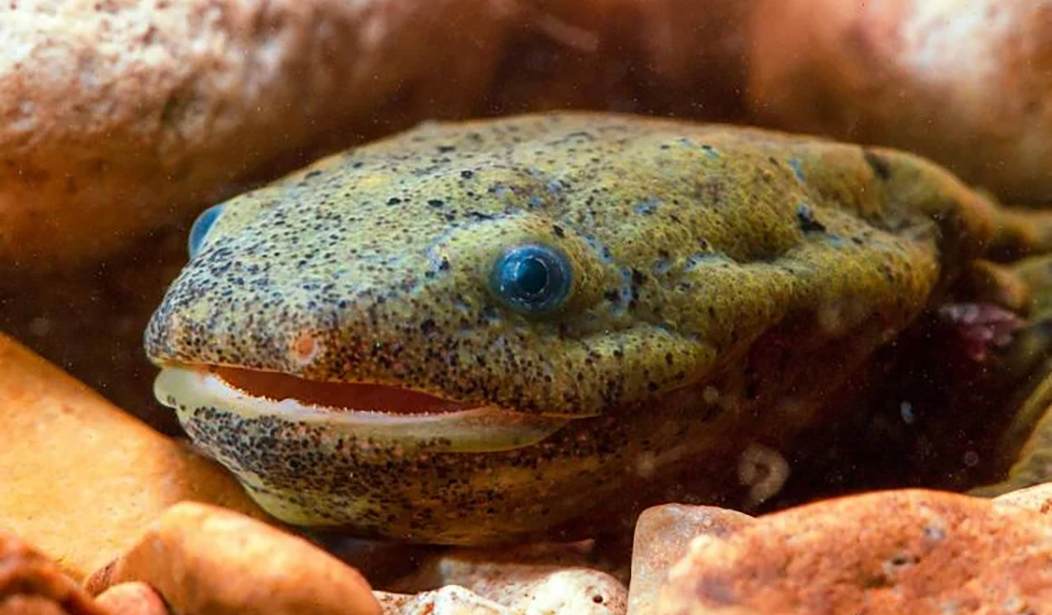One time, when I was eight or nine years old, I was wandering up and down the banks of eastern Iowa's Wapsipinicon (Wapsie) River, exploring while my grandfather was fishing. While walking along a muddy section of riverbank, I saw something wriggling in the silt and caught it. It was a curious beast, like a salamander, but it still had its feathery gills that normally only juvenile salamanders wear, and this one was big, maybe six inches long. I took it to show to Grandpa, wanting to know what it was.
"It's a mud puppy," he told me. "It's harmless. Best let it go." So I did, and later in my career, I would see these things in streams and rivers from time to time and let them go unmolested, remembering Grandpa's words. The mud puppy, like other salamanders, is an amphibian, and its life cycle is irretrievably tied to the water.
There is another, larger salamander in the United States, one that lives in a narrow range in the southeastern states. This one is called the hellbender, but it is also known as the grampus, the devil dog, the lasagna lizard, or - my favorite - the snot otter. Apparently, the snot otter populations are dwindling, and some intrepid biologists are working to help the hellbender sala-meander back to its former numbers.
"Hellbenders are difficult to find," says Andy Hill of the conservation organisation MountainTrue, where he is High Country regional director and Watauga riverkeeper, the key protector, watchdog and spokesperson for the Watauga River watershed. "They're perfectly camouflaged. We try to get into the mind of a hellbender – we identify quality habitat and look for clear, cold-running water. We look under every rock and crevice. You train your eye to look for movement – a blinking eye, a flash. You're elated every time you find one."
Every hellbender counts in the mission to save the largest aquatic salamander species in North America. The elusive, little-known freshwater amphibians, which can grow up to 29in (74cm) long, live in rivers in underwater caves or dens formed by boulders. They have broad, flat heads and stocky, flattened bodies that help them blend into rocky stream beds, with short strong limbs and small beady eyes on top of their heads. They're usually grey or brown in colour, with blotchy or mottled skin that helps them to remain camouflaged in rocky riverbeds.
Hellbenders are pretty inoffensive creatures. They don't bother game fish, as a rule. Unlike that mud-puppy in the silty Wapsie I described above, hellbenders prefer clear, clean waters to seek the insects, crayfish, worms, tadpoles, and other small creatures that they find newt-ricious.
See Related: Pennsylvania Custard Shop Discovers Stowaway Groundhog Stuck Inside Arcade Claw Machine
Enjoying Your Long Weekend in New Jersey? Beware of Venomous Copperhead Snakes!
We should be grateful for people like Mr. Hill and his compatriots in the MountainTrue organization. Without them, the survival chances of the hellbender may well be... mi-newt.
See, stories like this one just go to show you that you never know what you may learn next here at RedState; I'd be willing to bet that a fair number of readers have never before heard of an aquatic creature called a "snot otter." For even more, along with our usual menu of news, political analysis, and commentary, you really should consider upgrading to a VIP membership. Not only does it give you access to our exclusive content, but a Gold-level membership will also grant you access to all of the various Townhall sites, including PJMedia, Twitchy, Hot Air, Bearing Arms, and Townhall.com. Use the promo code SAVEAMERICA for a 50% discount!














Join the conversation as a VIP Member